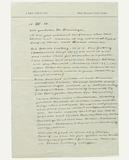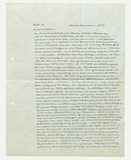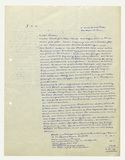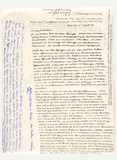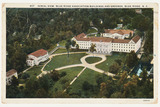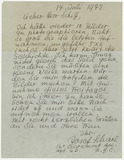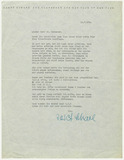John Heartfield: Wie im Mittelalter … so im Dritten Reich (1934)
A photo montage for the AIZ, with actor Erwin Geschonneck as modelIn the spring of 1934, the actor Erwin Geschonneck and the graphic designer John Heartfield lived in the same emigrant district in Prague. Heartfield was working on a photo montage for the Arbeiter Illustrierte Zeitung (AIZ), in which he juxtaposed a medieval window sculpture of the Tübingen Stiftskirche (showing the martyr George bound to a wheel) with a photograph of a victim of National Socialism (symbolically tied to the arms of a swastika).
Josef Albers: Concentric Squares (1941)
Albers described the aim of his teaching in 1970 as follows: “To open eyes. […] Not to just let things wash over you passively, but to see for yourself, to search, find, discover and experience. Yes: You can learn to see creatively!” (ed. trans.)
Josef Albers: Letter to Alfred Neumeyer (15 August 1938)
It took time for many émigré artists to be able to live from their art while in exile. Even well-known personalities found themselves cast back to their laborious beginnings.
Josef Albers: Letter to Gertrude Maud Grote (14 October 1941)
Josef Albers: Letter to Ludwig Grote (2 September 1951, presumed)
At first glance, it appears to be a wartime document. Josef Albers dated his letter to Ludwig Grote "II.
Josef and Anni Albers: Letter card to Charlotte Hesse (c. 1949)
Josef Albers had made a name for himself in Germany as a designer of glass paintings with an abstract, geometric design vocabulary, as shown in the picture on the letter card. The drafts were produced during his time at the Bauhaus and were made for an industrial production.
Josef and Anni Albers: Letter to Charlotte Hesse (1947)
The letter from the painter and graphic artist Josef Albers and his wife, the textile designer Anni Albers, comes from the estate of the former Dessau housemaid Charlotte Hesse. The correspondence allowed them to maintain contact between their old and new homeland.
Josef and Anni Albers: Postcard to Charlotte Hesse (1933)
Anni and Josef Albers, who were both Masters at the Bauhaus in Berlin, lost their work when it closed. In spite of her Protestant faith Anni Albers, who was born Anneliese Fleischmann in Berlin, was regarded by the Nazis as a Jew.
Josef Scharl: letter to a photographer named Schiff (14 July 1942)
Writers forced into exile by Hitler’s oppression were able to rapidly distribute new works by circulating manuscripts among friends and publishers. A manuscript, after all, can be easily sent through the post. Paintings, on the other hand, must first be photographed. For the painter Josef Scharl, in New York exile in 1942, this meant resorting to pleading.
Josef Scharl: Letter to Alfred Neumeyer (16 July 1950)
The painter Josef Scharl was indebted to writer and art historian Alfred Neumeyer for a sensitive interpretation of his work. The appraisal appeared in 1945 in Karl Nierdendorf’s Scharl monograph. The two German emigrants continued to correspond afterwards.



